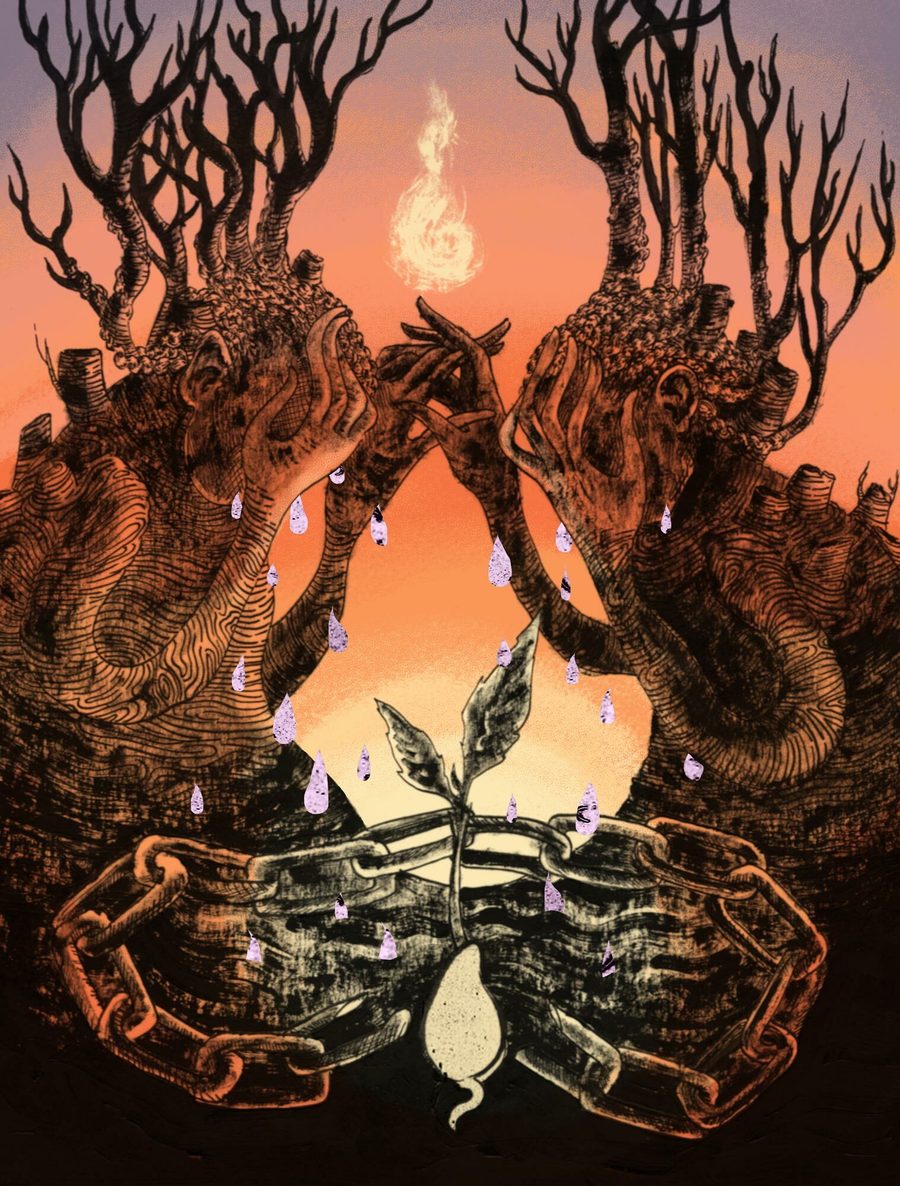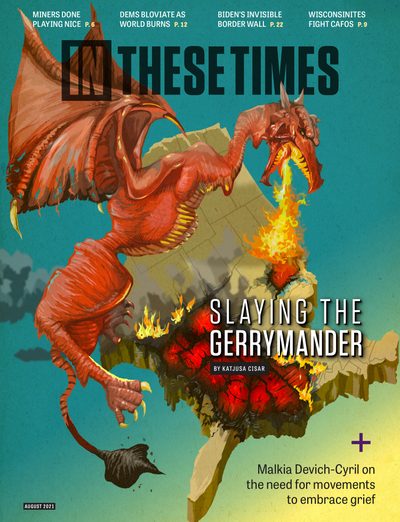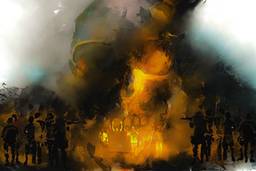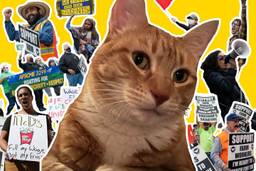Grief Belongs in Social Movements. Can We Embrace It?

A Black activist reflects on intergenerational trauma, community, and coming to terms with death in movement building.
The morning my mother died was cold and dark, and the snow fall outside was frenzied and piling high. I’d put my headphones on in the night to block out the loud hiss and moan of my mother’s oxygen machine. I was tired. Less than six months after founding the Youth Media Council, which would later become the organization MediaJustice, doctors told my sister and me that sickle cell anemia, a fatal genetic blood disorder, was finally and actively taking my mother’s life. For three years following the end-stage diagnosis I flew home from Oakland to Brooklyn for one week every month to relieve my sister of caregiving duties.
As I stood above my mother’s deathbed, her body curved like a crescent moon, my hands a sickled semi-circle around her, a feeling of abject failure gurgled in my throat. I couldn’t swallow it. I couldn’t spit it out.
My mom, a single mother and a leader in the Harlem chapter of the Black Panther Party, had passed to me all of my politics and seeded in me all the things that I am, good and bad. My mother stood for me when no one else did, and she died while I slept. On my watch. That guilt, the incongruence between working daily to heal the world but being unable to save my mother’s life, was powered by the illusion of my control over life and death — an entire worldview centered on my failure.
I had already helped seed a half dozen groups and even more ideas. I was one of the leaders diversifying and forging an emerging media justice sector. I was making the kind of difference I had always wanted to make. I could coordinate campaigns and build communities, I could navigate wins and losses with order, plans, brains. That’s what I thought. I could control this.
Instead of surrendering to grief ’s momentum, I backed away from it with everything I had. I continued to run away for the next five years. I ran into nicotine, into alcohol, into sex. I ran into drama and conflict. But more than anything, more than everything, I ran headfirst into my job. I worked all through the night, at bars and at conferences. Everywhere, all the time.
During those first five years after my mother’s death, I entered what poets and psychologists alike have dubbed the “dark night of the soul,” a stage in personal development when a person undergoes a difficult and significant transition, and the previous frameworks like identity, relationship, career, habit or a belief system that previously gave life meaning no longer do. Author and grief activist Francis Weller suggests that while this dark night can often look like depression, it is actually the deformation of personality that occurs when oppression forces individuals, communities and generations to carry grief as a solitary burden. He says “the psyche knows we are not capable of handling grief in isolation.” Whether the message is coming from the nation-state, your employer, or family and friends, when the message is “Get over it. Get back to work,” people frequently try to numb themselves to cope with the discomfort of loss and the feelings of extreme deprivation and isolation that can follow.
As is the way with major loss, my mother’s death hallowed me, knocked me to my knees and emptied me until there was nothing left but holy ground. It was in that tender and sacred state that I reconnected with Alana Devich, the queer Black femme from my college alma mater who would become my best friend, then my soulmate and then my wife. Alana’s quiet, stubborn quirk was a kind of genius to me. It made her the most insightful and wittiest person I had ever met. Her kindness was threaded through with a streak of melancholy, a freshly tendered gratitude that saw and delighted in everything, even me. Especially me. It may be the reason that when I put my cheek on her cheek and asked her to marry me, she didn’t hesitate. She said yes. Even when I asked her again and again. She said yes and I was ready. I was certain the world had already taken from me all it was going to take. Loss had ravaged me, but it had not won.
The year after our wedding was a blissful one. We traveled. Made plans to move from our junior one-bedroom to a larger place with room for our future. We talked about buying a house. So it was a heartwrenching shock when an oncologist walked into the office where we sat, arms around each other, and diagnosed Alana with an incurable end-stage gastroesophageal cancer that had already invaded her liver, lungs, esophagus, bones. Alana said she wanted to fight, and, oh, we did. As we worked our way through crisis after crisis, through 12 rounds of 56-hour chemotherapy infusions, weekly IV hydration, frequent emergency hospitalizations, surgery and rehab, I continued to work as executive director of Media Justice. Fundraising. Staff meetings. Human relations. Strategic campaigns. It almost broke me. My wife, of whom I will forever be in constant awe, fought an exhaustive two-year battle against a painful, disabling and debilitating cancer. Alana Devich Cyril, a woman who brought me closest to my truest self, also brought me face-to-face with sacred death. She died peacefully at the young age of 42 in my arms, at home.
I’d spent the five years after my mother’s death becoming a driven and overworked executive movement leader. I tried desperately to fill the hollow grief had carved into my life by seeking familial connections with co-workers, bonding over our shared history of trauma and loss. I joined the community that would become the somatic transformation group Generative Somatics and, over a decade, off and on, founder Staci Haines and others taught me practices that ultimately helped me integrate my traumatic loss. In those years, I led my organization to win national campaigns that affected the lives of hundreds of thousands of people. I helped to build a new media justice and digital rights social justice sector. At times, I did so in ways that didn’t center the dignity in myself and others. I learned the hard-won lesson that grief demands its due, and it will take by force what is not freely given.
But this journey through what experts call “complicated grief,” in which the bereaved person experiences debilitating feelings of extreme loss that don’t improve or integrate over time, is what revealed to me this truth: that in order to give my heart to love and my hands to freedom movements, I had to first understand and attend to grief.
***
My mother’s death wasn’t my first major loss, it just had the greatest impact. By the time I was 30, I had an intimate relationship with death and dying. I had grown up in Bedford-Stuyvesant in Brooklyn in the 1980s, when Black bodies were felled like great trees, cut down by bullets, by intimate violence, by accidents and disease. I knew death, but I did not recognize the grief sitting, unmoving, in my skin. I grew heavy with it, angry, defensive.
To be Black, Indigenous or a member of any oppressed class in America is to know traumatic loss. As humans, we are hardwired for the fact that death is a natural part of life. While loss is deeply uncomfortable, we can learn to adapt to the natural phenomenon of loss. But when structural inequalities produce major and secondary losses, leading to widespread collective grief, death is out of balance with life. Individual and collective, repeated and generational, traumatic loss stacked on top of existing natural loss. We must tear down the systems, institutions and narratives that engineer death, fuel it and simultaneously distract us from it. This essential rebalancing act is the charge of 21stcentury social justice movements.
What becomes possible when movements are brought more healthfully to grief, and what can we do to support leaders, organizations and movements to get there?
Cheryl Espinosa-Jones, a grief counselor, author and the host of the Good Grief radio show at VoiceAmerica, offered me four steps for moving through grief, which I interpreted as an offering not only for individual activists and leaders but also for organizations and social movements as a whole.
Step 1: Feel the loss fully. Espinosa-Jones makes it plain: “Grief knows what it’s doing.” Grief is wise and ancient and knows what to do. When we interrupt grief’s processes, or ignore them, it can lead to apathy, addiction and unhealthy forms of anger. What loss hates most is to be ignored.
Yet, for centuries, systems of racial, economic and gender hierarchy have disenfranchised the grief of people of color, women, children, disabled people, queer and trans communities, and the poor. Dominant narratives about grief have turned gaslighting into an art form, convincing us that it is safer to deny grief than to feel it. At every turn, we are persuaded that grief is a wild, unacceptable emotion that must be handled, managed, overwritten and hidden. We are pressured by political and even physical force to prioritize productivity over personal well-being, to seek eternity over embodied presence, even as we live through the most traumatic losses.
For each Black life taken by police or interpersonal violence, how many spouses, siblings, children or parents had sufficient bereavement leave? What would happen if Black diasporic communities were to fully embody the losses of land, culture and freedom emerging from chattel slavery? Would agency or apathy be the result if immigrant communities could steep in the loss of land, language and family? Would Indigenous communities across the globe have more or fewer negative health outcomes if there were space to feel and then transform the grief of genocide? As we seek to breathe a new world into being, being an effective changemaker demands the right and power to feel our losses rather than escape them. We must give our grieving bodies what they need, individually and collectively.
Stop conflating health and productivity. Stop giving positive feedback when staff immediately return to work, appear less emotional or don’t ask for appropriate accommodations following a major loss. The systems of inequality we seek to transform reject what Espinosa-Jones calls “a relational culture.” Meaning: a culture of noticing and acknowledgment. Violently enforced inequality makes truth, reconciliation, reparations and accountability impossible. Becoming aware of grief gives us more choices about how to respond to grief and opens up possibilities to approach grief not only with compassion for self and others, but also with joy. Joy is not the opposite of grief. Grief is the opposite of indifference. Grief is an evolutionary indicator of love — the kind of great love that guides revolutionaries.
Step 2: Seek solace and comfort. As we expand a broad awareness of grief, we learn to approach our own grief and the grief of others without judgment. We practice the art of accompaniment without casting any part of ourselves out. Denying grief denies humanity. Yet, becoming aware of one’s own grief, reaching out for professional or peer support, and owning your grief journey can open your awareness until you see grief you didn’t even realize was there.
When people are facing traumatic grief, professional support is an important intervention. Many hospice programs host free bereavement groups and counseling open to the community regardless of health insurance. But, since grief itself is a natural process, seeking or building peer support is equally valid. In community, we can move together, take action that can help metabolize sorrow and transform grief, releasing impossible goals such as eliminating grief.
During times of massive collective loss, let us rebuke apathy by reimagining social justice organizations and formations as vehicles to metabolize and transform grief into agency. This requires resilient infrastructure and embodied methodology. Resilient infrastructure may include creating special funds and referral lists that support staff healing; offering extended bereavement leave policies; cross-training staff to increase organizational redundancy; and supporting staff boundaries. At the end of the day, the question is whether your leaders and staff have the skills to recognize grief and the resources to respond when it appears.
As societies or social movements, we must develop resilient adaptations that increase the elasticity of our responses to loss. Otherwise, our adaptations can morph into a traumatized response that relies heavily on traumatic bonds and decreases the strategic effectiveness and staying power of social movement organizations and leaders.
Religions prescribe practices to manage grief, and movements need to do so as well. When social movements have neither the infrastructure nor leadership to enable the mass metabolizing of grief, they fracture under the weight of it, just like people do. If we could expand the social infrastructure for grief beyond hospice and faith, consider the kind of democratic social movements our civil society would give birth to.
Step 3: Find inspiration. In the civil rights, Black Power and Third World Liberation movements of the 1960s, organizations and campaigns used song, poetry and other art forms to support the transformation of grief into a wise protagonism and active agency. Art in all its forms allows grief to reveal us, gives sorrow words, deepens our gratitude with grief’s weight and reminds each of us that only those who grieve profoundly can love deeply — and from loving one another, we grow our agape love for the world. That’s why I launched the Pandemic Joy Community, a volunteer weekly online gathering, where I and approximately 40 others meditate, pour libations, sing and testify. It is why my wife would step out into the full moon’s light, or pull tarot cards under the new moon. It is why my mother played Billie Holiday at full volume and read poems to my sister and me on the floor of Liberation Bookstore in Harlem.
Step 4: Take action from this place of grounded grief. In our conversation, Espinosa-Jones reminded me that an individual’s psychology can heal by finding the courses of action that match one’s felt need— but there are no skipped steps. Sitting with discomfort is always first, followed by connection and inspiration — but at the end of the day, we need action to metabolize grief and transform our material and cultural conditions. Metabolized grief can power deep and lasting change infused with profound joy, while unmetabolized grief becomes an almost insurmountable barrier to it.
***
“Interregnum” is the term given to the uncertain period between times of stable government when anything might happen: civil unrest, war between nations, the rise of militias and other warlords, power vacuums, succession wars. When these periods of instability end, the dust settles and the victors restabilize the empire; there is often a new geography, new borders, new lines of delineation. Between the late 1920s and early 1930s, the Italian writer and political theorist Antonio Gramsci was incarcerated in a fascist prison, writing about what he considered to be a new interregnum, a Europe that was tearing itself apart. He wrote of anticipated war between nations, civil unrest and repeated changes in the lines of geographic possession: “The crisis consists precisely in the fact that the old is dying and the new cannot be born; in this interregnum a great variety of morbid symptoms appear.” Or, in its more common phrasing, “The old world is dying, and the new world struggles to be born: Now is the time of monsters.”
In the 21st century, our cities smell more and more like fire. As the old world dies and a new one struggles to be born, the morbid symptoms of which Gramsci spoke are showing their monstrous faces and spreading their deliberate pain like a bruise across the skin of the planet. White supremacy, capitalism and patriarchy are ideological and structural systems that both beget and reject grief, fuel destructive violence, and keep communities clinging to the old world, clinging to how things were instead of imagining what it could be, clinging to the ideology of control. Attempting to control life is often an attempt to escape death.
But death belongs; it’s not the burden. Death is a natural part of every life cycle. Our bodies will die. Our organizations will die. Our movements will die. Likewise, the specific conditions that oppress our families and communities will also come to an end. Endings are not to blame. Loss is simply an element of change. Change is the heartbeat of social movement. But, on either side of change is loss. Reimagining the world requires that we release the parts of the system and ways of being that are ready to die, and mourn the destructive losses that we could not control, despite our best efforts.
Something is dying, and we are desperate for something new to be born. We can feel it, quivering with hope at the edge of a century. It is a firecracker dancing across a night sky. A languid score of Black music moving effortlessly in the street. The fires call to us like beacons across state lines, a collective grievance demarcating what was from what will be. Here. Now. Grounded grief is a vaccine against the morbid conditions bred by white supremacy, a patriarchy that has distorted our families and relationships, a concentration of wealth that has disconnected us from nature and directed everything brilliant and beautiful to profit. Only through the compassion and loneliness and love inherent in grief can we forge a world out of the fire that will not replicate ancient hierarchies.
Along my own journey, what surprised me most was the discovery that grief is not an enemy to be avoided. In fact, resisting grief led to my suffering, while becoming intimate with grief led me to the lesson that grief and joy are inextricably linked. Though generations of traumatic loss can become conflated with deformed expectations, standards and culture, grief in all its forms has the potential to bring us closer to the truth of the world, to make us more tender and more filled with delight. It is from this new kind of gratitude, this pandemic joy, that we can rise together in action, in democratic decision-making, in strategic vision. This is one part of liberation.
As we strip away the chains of nation-state to become true patriots to the nation that has not yet been born — the one beyond national borders and prison bars, the one forged in the fire of a deep, abiding love with an economy steeped in dignity and rights — we can come to know a richly resilient grief rather than a desperate, starving one.
When we bring our fights to the watering hole of grief, our political systems, natural environment, economic frameworks, civil society and culture all become living, breathing memorials to what we have lost. What we have lost becomes found, witnessed, honored. In this way, all social justice and human rights work is a collective act of gloried mourning.
To have a movement that breathes, you must build a movement with the capacity to grieve.
Excerpted from Holding Change: The Way of Emergent Strategy Facilitation and Mediation by adrienne maree brown (AK Press, 2021).
Malkia Devich-Cyril is an award-winning activist, writer and public speaker on issues of digital rights, narrative power, Black liberation and collective grief, as well as the founding and former executive director of MediaJustice, a national hub boldly advancing racial justice, rights and dignity in a digital age. Malkia now serves as the organization’s senior fellow, with a focus on grief in a digital age.





